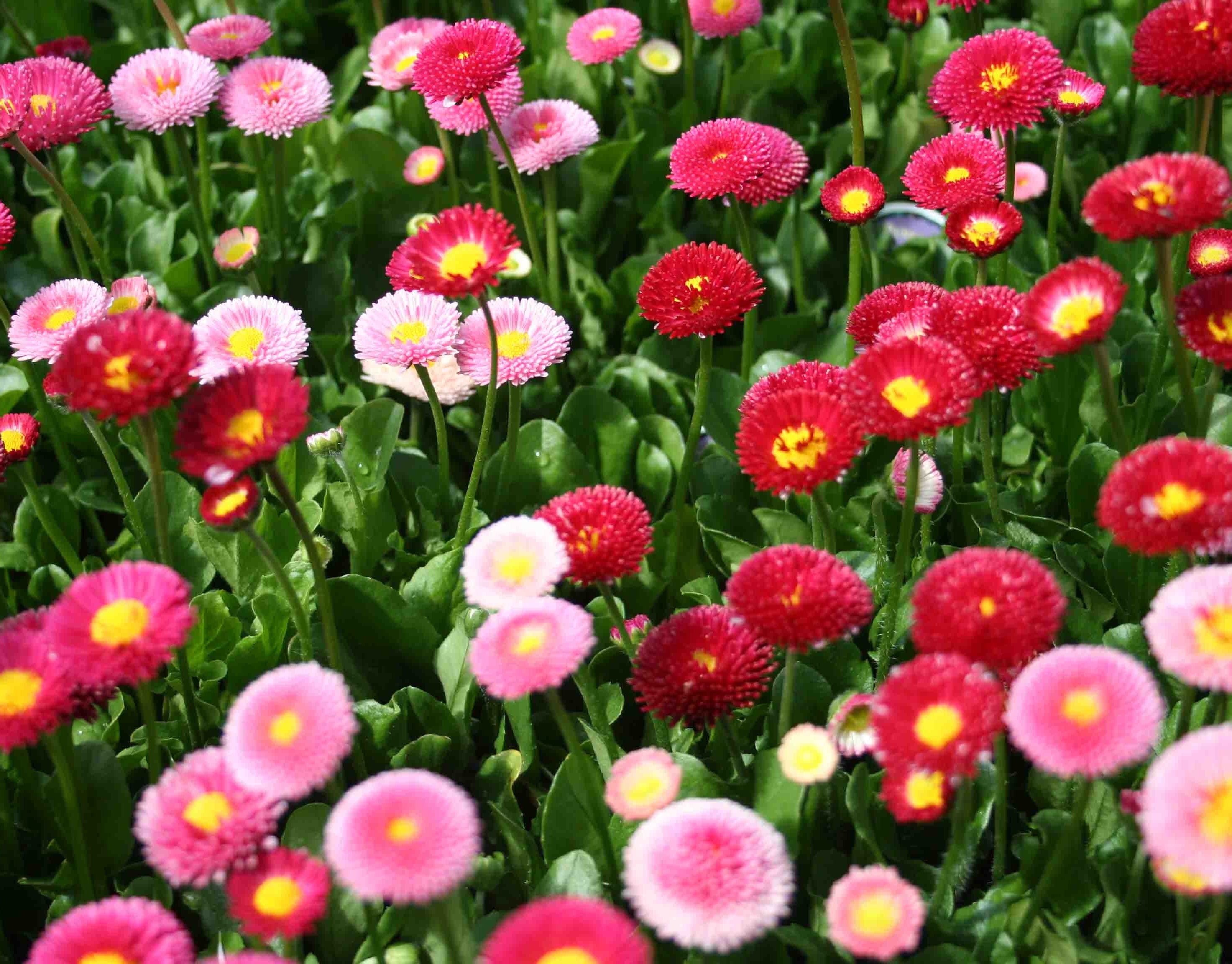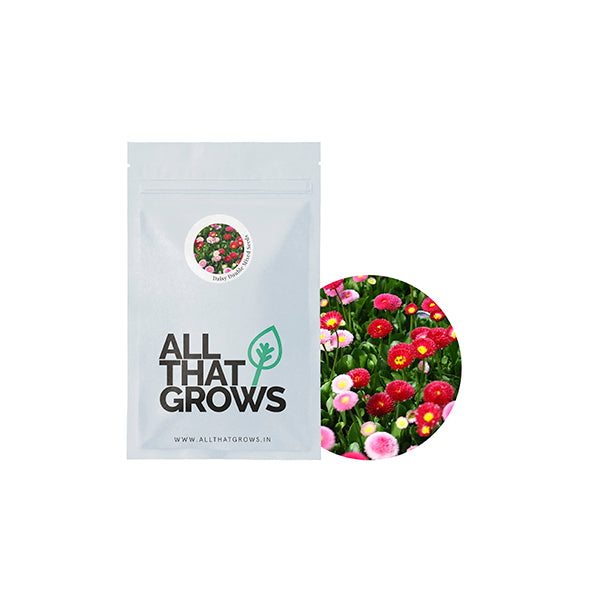



Daisy Double Mixed Seeds
Seed Type : Non-Hybrid, Open Pollinated and Non-GMO
Plant Height : Grows up to 30-35 cm high
Flower Shape: Tubular centre with thin ray like petals
Colour : White, red, maroon and pink
Specifications : Long flowering period, Suitable for cut flowers.
- SOWING
TIMEOct-Nov
- Sowing
Distance10-15 cm plant to plant
- Fruit
WeightN/A
- Fruit
ShapeN/A
- Days to
maturity60-90 days
- Details
- How to sow
- Reviews
Daisy Double Mix is a winter flower that blooms in an array of shades. It is a dwarf, dense flowering plant that serves well as pot plants and flower beds. Daisies belong to the daisy family of Compositae, now known as Asteraceae in flowering plants. Daisies are native to north and central Europe. Daisies are an easy to grow perennial, that brightens the flower garden, and is great for indoor vases and arrangements. While there are dozens of varieties of daisies, the most popular are the Shasta Daisy, Painted Daisy, and African Daisies. Daisies like rich, well drained soil and full sunshine. They will readily tolerate poorer soils and partial shade as well. Daisies are among the most popular of flowers of both gardeners and non-gardeners. These flowers are also known to be the best for kids and beginners. Daisy is not only a beautiful ornamental addition to your home but its leaves are edible and can make a tasty companion to your salads. They are closely related to artichoke and are high in Vitamin C. Daisies also have lots of medicinal properties along with beauty.
Planting instructions
Soil should be collected in a garden pot mixed with well rotten cow dung or manure.
Broadcast the seeds over the soil bed and cover it with a thin layer of sieved sand to allow germination.
Maintain a distance of 1.0 feet between the plants.
Sprinkle little water and then as per requirement keeping the soil moist.
Flowering starts after 45-50 days post transplant which continues for 100-120 days depending on the variety.
Growing Requirements
pests
Marigolds are susceptible to damping off (Rhizoctonia solani) and pests like collar rat, Sclerotium rolfsii, Botrytis cinerea, Powdery mildew and cucumber mosaic. The major symptom for these pests is light brown spots on the lower leaves or on early seedlings. To prevent these diseases, ensure proper drainage and ventilation and avoid over watering.
soil
Sandy loamy soil with pH 5.6 to 6.5 is ideal for its cultivation.
spot
Place in a spot that receives either full sun or partial sunlight.
temperature
20-25°C
watering
Regular watering keeps the flowers healthy. You can use a water can or a water spray.
how to harvest
For harvesting marigold, loose flowers are plucked when they attain full size depending upon the variety. Flowers should generally be harvested in the morning hours. Irrigation of soil with water,before plucking, gives better flower quality. Also, plucking of flowers regularly and removal of dried flowers enhances the yield.

Customer Reviews
The productiveness of any seed we sell is subject to your local climatic conditions*, the sowing method you adopt, and your commitment to the planting process. We give no warranty, expressed or implied, and are in no way responsible for the produce.
Please note that all our seasonal recommendations/ sowing information is as per the local climatic conditions. *For more information on the optimum conditions required for growing seeds in your region, please contact us at, hello@allthatgrows.in or Whatsapp us at, +91 8544865077
Questions & Answers
Have a Question?
Be the first to ask a question about this.




Daisy Double Mixed Seeds
Seed Type : Non-Hybrid, Open Pollinated and Non-GMO
Plant Height : Grows up to 30-35 cm high
Flower Shape: Tubular centre with thin ray like petals
Colour : White, red, maroon and pink
Specifications : Long flowering period, Suitable for cut flowers.
Daisy Double Mix is a winter flower that blooms in an array of shades. It is a dwarf, dense flowering plant that serves well as pot plants and flower beds. Daisies belong to the daisy family of Compositae, now known as Asteraceae in flowering plants. Daisies are native to north and central Europe. Daisies are an easy to grow perennial, that brightens the flower garden, and is great for indoor vases and arrangements. While there are dozens of varieties of daisies, the most popular are the Shasta Daisy, Painted Daisy, and African Daisies. Daisies like rich, well drained soil and full sunshine. They will readily tolerate poorer soils and partial shade as well. Daisies are among the most popular of flowers of both gardeners and non-gardeners. These flowers are also known to be the best for kids and beginners. Daisy is not only a beautiful ornamental addition to your home but its leaves are edible and can make a tasty companion to your salads. They are closely related to artichoke and are high in Vitamin C. Daisies also have lots of medicinal properties along with beauty.
Seed Type : Non-Hybrid, Open Pollinated and Non-GMO
Plant Height : Grows up to 30-35 cm high
Flower Shape: Tubular centre with thin ray like petals
Colour : White, red, maroon and pink
Specifications : Long flowering period, Suitable for cut flowers.
- SOWING
TIMEOct-Nov
- Sowing
Distance10-15 cm plant to plant
- Fruit
WeightN/A
- Fruit
ShapeN/A
- Days to
maturity60-90 days
Planting instructions
Soil should be collected in a garden pot mixed with well rotten cow dung or manure.
Broadcast the seeds over the soil bed and cover it with a thin layer of sieved sand to allow germination.
Maintain a distance of 1.0 feet between the plants.
Sprinkle little water and then as per requirement keeping the soil moist.
Flowering starts after 45-50 days post transplant which continues for 100-120 days depending on the variety.
Growing Requirements
pests
Marigolds are susceptible to damping off (Rhizoctonia solani) and pests like collar rat, Sclerotium rolfsii, Botrytis cinerea, Powdery mildew and cucumber mosaic. The major symptom for these pests is light brown spots on the lower leaves or on early seedlings. To prevent these diseases, ensure proper drainage and ventilation and avoid over watering.
soil
Sandy loamy soil with pH 5.6 to 6.5 is ideal for its cultivation.
spot
Place in a spot that receives either full sun or partial sunlight.
temperature
20-25°C
watering
Regular watering keeps the flowers healthy. You can use a water can or a water spray.
how to harvest
For harvesting marigold, loose flowers are plucked when they attain full size depending upon the variety. Flowers should generally be harvested in the morning hours. Irrigation of soil with water,before plucking, gives better flower quality. Also, plucking of flowers regularly and removal of dried flowers enhances the yield.



 Sign In
Sign In








